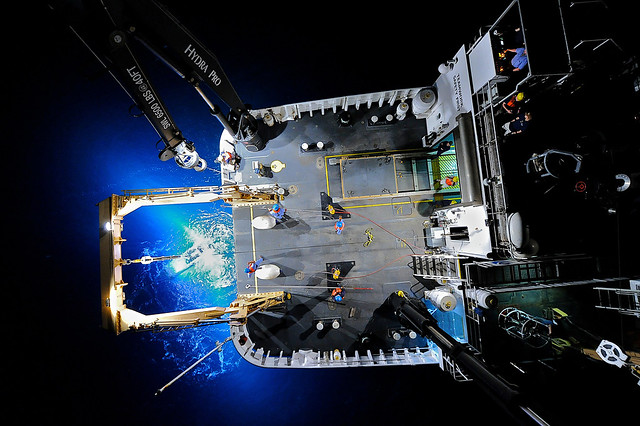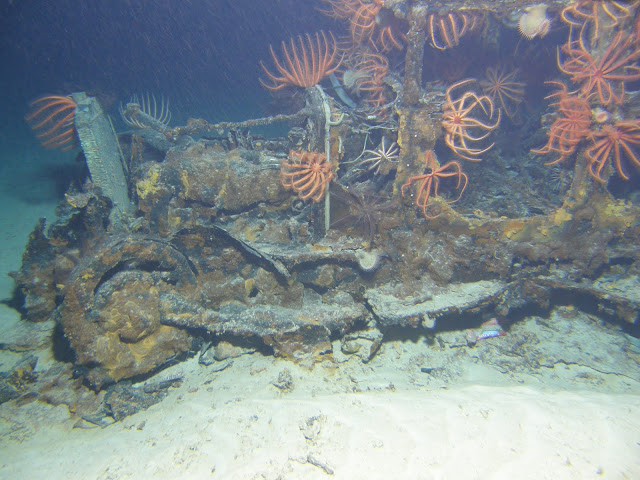So, on August 1, the NOAA research vessel Okeanos Explorer begins its first livestream ROV dive as part of the 2015 Hohanu Moana Expedition to investigate the deep-sea habitats of the Hawaiian Islands region.
At the moment, the Explorer has been mapping the region and you can see all of this live, but come Saturday you'll be able to watch the actual EXPLORATION of the Hawaiian deep-sea here:

Why am I so Farkin' excited about this??
I've been studying deep-sea Hawaiian starfish since the mid 1990s and in fact, my very first EVER publication was a checklist of Hawaiian starfish based on material at the Bishop Museum in Honolulu. In 2001 I got to actually go to the BOTTOM of the Hawaiian deeps! (about 1000 m I think?) in the submersible Pisces V.
So, to actually be able to SEE all of these species with High-Definition video?? EXCITING!!
What Sorts of Starfish and other Echinoderms Will We See??
As with past Okeanos Explorer dives, the dives will involve a Remotely Operated Vehicle deployed to the deep-sea with narration but also with ONSHORE support via phone, computer and social media. That includes me and a veritable ARMY of other marine biologists, including ecologists, taxonomists (i.e. people who identify different species) and geologists.I've helped summarize the various starfish species seen on Okeanos Explorer dives in the North Atlantic (here). But the diversity in the Hawaiian region and especially in the Pacific is fair bit MORE diverse!
The folks at the Hawaiian Undersea Research Laboratory have an "ID Gallery" not just of Sea stars but of ALL the many different animals found at depth here... from crustaceans to corals and sea urchins to fish!
There's the potential to encounter one of approximately 55 species of deep-sea asteroids described in the Hawaiian region (that's not including any shallow water species).
I've had the pleasure of describing at least four NEW species in the Hawaiian region, including Apollonaster kelleyi, named for Dr. Chris Kelley who will be one of the science leads on the Okeanos team!
We may even get to see my other new species, Astroceramus eldredgei (named for Lu Eldredge at the Bishop Museum) in glorious feeding action!
 |
| Image courtesy of HURL |
 |
| Image courtesy of HURL |
- The deep-sea sea urchins of Hawaii (here)
- The deep-sea starfish of Hawaii (here)
- Some of my work with brisingid sea stars (here).
The Okeanos live stream has played a big role in part of a new and fascinating dynamic to deep-sea research! Citizen Science!
Now ANYONE around the world can watch a live streamed research cruise! (Note: Google is GREAT at helping calculate the time differences in different parts of the world).
But how does the citizen science thing work?
Screengrab software is pretty much a free feature on computers. My macintosh has it and I'm pretty sure most PCs have it. And if it doesn't already come with it, you can probably download some free software for it. There are even software apps that allow you to take short movies off the video feed.
So, basically, ANYONE can basically take a screengrab off the feed and contribute to a larger community of scientists and other interested people who are interested in deep-sea biology!!
IF YOU SEE SOMETHING NEW you will see it along WITH the scientists and the entire world!
Who knows? Maybe a screengrab that YOU take could lead to a new discovery!!
Where do you find these and how do you contribute?
There's TWITTER of course! Hashtag it with #Okeanos and Boom! there it goes! If I can, I actually make it a point to LIVE TWEET any identifications and observations I make off the live stream..
#Okeanos This urchin is Heterobrissus hystrix! Is aggregation FIRST TIME OBSERVED???. @quattrinia @ademopoulos pic.twitter.com/ksQ89AdAqa
— Christopher Mah (@echinoblog) April 29, 2015
In addition to my Twitter handle: @echinoblog, others scientists and biologists who are usually watching include@ademopoulos An ecologist at the US Geological Survey
@DrChrisKellogg A microbiologist/coral biologist
@CarinaDSLR A marine biology PhD student
But there are often many, many more...
The other interesting option is the FACEBOOK Underwater webcams Screenshot Group! So, basically if you join, this group is made up of nearly 1000 people (some scientists but many are not) that are just taking and posting screengrabs from underwater live stream video including R/V Nautilus and Okeanos Explorer.
There's usually someone on taking a grab of something almost 24 hours a day. If you missed that cute dumbo octopus?? Not to worry, in all liklihood, someone took a screen grab of it on this group!
If you see something during the Okeanos feed, you can usually ask someone on Twitter or in the Facebook group and one can usually get a response the same day.. There are innumerable taxonomists and scientists monitoring. Some will call in on the phone, which you'll be able to hear on the live stream, others may add information via the Facebook group while others such as myself may Tweet an answer.
New discoveries happen pretty regularly. New behavior. New species. Sometimes even rarely seen species! On the last Okeanos Cruise, you may remember that they observed a deep-sea starfish which had not been seen since 1878 (130 years!)
Who knows what we shall discover in Hawaii???
The other interesting option is the FACEBOOK Underwater webcams Screenshot Group! So, basically if you join, this group is made up of nearly 1000 people (some scientists but many are not) that are just taking and posting screengrabs from underwater live stream video including R/V Nautilus and Okeanos Explorer.
There's usually someone on taking a grab of something almost 24 hours a day. If you missed that cute dumbo octopus?? Not to worry, in all liklihood, someone took a screen grab of it on this group!
If you see something during the Okeanos feed, you can usually ask someone on Twitter or in the Facebook group and one can usually get a response the same day.. There are innumerable taxonomists and scientists monitoring. Some will call in on the phone, which you'll be able to hear on the live stream, others may add information via the Facebook group while others such as myself may Tweet an answer.
New discoveries happen pretty regularly. New behavior. New species. Sometimes even rarely seen species! On the last Okeanos Cruise, you may remember that they observed a deep-sea starfish which had not been seen since 1878 (130 years!)
Who knows what we shall discover in Hawaii???








No comments:
Post a Comment